Peterborough, Ontario
| City of Peterborough | |||
|---|---|---|---|
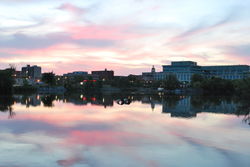 |
|||
|
|||
| Nickname(s): "The Electric City", "Ptbo", "The Patch", "Peterpatch", "P-dot", "Beaterborough" | |||
| Motto: Dat natura, elaborant artes (Nature Provides, Industry Develops) |
|||
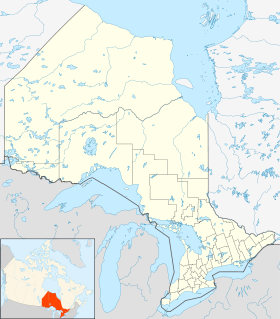 Peterborough
|
|||
| Coordinates: | |||
| Country | |||
| Province | |||
| County | Peterborough County | ||
| Established | 1819 - Scott's Plains | ||
| Incorporated as town | 1850 - Peterborough | ||
| Incorporated as city | July 1, 1905 | ||
| Government | |||
| - Mayor | Paul Ayotte | ||
| - MP | Dean Del Mastro (CPC) | ||
| - MPP | Jeff Leal (OLP) | ||
| Area[1][2][3] | |||
| - Land | 58.40 km2 (22.5 sq mi) | ||
| - Urban | 70.82 km2 (27.3 sq mi) | ||
| - Metro | 1,505.56 km2 (581.3 sq mi) | ||
| Elevation | 195 m (640 ft) | ||
| Population (2006)[1][2][3] | |||
| - City | 74,898 | ||
| - Density | 1,282.6/km2 (3,321.9/sq mi) | ||
| - Urban | 76,925 | ||
| - Urban density | 1,086.2/km2 (2,813.2/sq mi) | ||
| - Metro | 116,570 | ||
| - Metro density | 77.42/km2 (200.5/sq mi) | ||
| Time zone | Eastern (EST) (UTC-5) | ||
| - Summer (DST) | EDT (UTC-4) | ||
| Postal code span | K9H, K9J, K9K, K9L | ||
| Area code(s) | 705 | ||
| Website | www.peterborough.ca | ||
| Pop. Change (2001–2006): 4.8% Dwellings: 33,042¹ ¹ According to the Canada 2006 Census |
|||
Peterborough is a city on the Otonabee River in (Central-Eastern) southern Ontario, Canada, 125 kilometres (78 mi) northeast of Toronto. The population of the City of Peterborough was 74,898 in the 2006 census, while the census metropolitan area (CMA) had a population of 116,570. It presently ranks as the 33rd and smallest CMA in Canada. The current mayor of Peterborough is Paul Ayotte.
Peterborough is known as the gateway to Kawarthas, "cottage country", a large recreational region of the province. It is named in honour of Peter Robinson, an early Canadian politician who oversaw the first major immigration to the area. The city is the seat of Peterborough County and since 1983 has been sister city to Ann Arbor, Michigan.[4]
Contents |
History

Pre-European settlement era
First Nations groups followed retreating glaciers into the area 11,000 years ago. Woodland Natives inhabited the area circa 1000 BC to AD 1000, followed by Iroquois and Mississaugas circa 1740. Two of the more prominent sites surviving from this time are the petroglyphs at Petroglyphs Provincial Park and Serpent Mounds. The petroglyphs are located northeast of Peterborough and are generally believed to have been carved by the Algonquin people between 900 and 1400 CE, although there are alternate theories which are not as widely held. The Serpent Mounds are located near Keene, approximately 30 km southeast of Peterborough in Otonabee-South Monaghan township, in an area first inhabited over 2000 years ago.[5]
In 1615, Samuel de Champlain travelled through the area, coming down from Lake Chemong and portaging down a trail, which is approximated by present day Chemong Road, to the Otonabee River[6] and stayed for a brief time near the present-day site of Bridgenorth, just north of Peterborough.
19th century
In 1818, Adam Scott settled on the west shore of the Otonabee River. The following year he began construction of a sawmill and gristmill, establishing the area as Scott's Plains. The mill was located at the foot of present-day King Street and was powered by water from Jackson Creek.
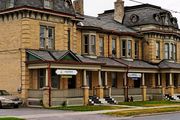
The year 1825 marked the arrival of 1,878 Irish immigrants from the city of Cork. In 1822, the British Parliament had approved an experimental emigration plan to transport poor Irish families to Upper Canada. The scheme was managed by Peter Robinson, at the time a politician in York (present-day Toronto). Scott's Plains was re-named Peterborough in his honour.
In 1845, Sandford Fleming, inventor of Standard Time and designer of Canada's first postage stamp, moved to the city to live with Dr. John Hutchison and his family, staying until 1847. Dr. John Hutchison was one of Peterborough's first resident doctors.
Peterborough was incorporated as a town in 1850 (population 2,191).
Beginning in the late 1850s, a substantial canoe building industry grew up in and around Peterborough. The Peterborough Canoe Company was founded in 1893, with the factory being built on the site of the original Adam Scott mill. By 1930, 25% of all employees in the boat building industry in Canada worked in the Peterborough area.[7] The period from 1928–36 saw the establishment of the Johnson Motor Company/Outboard Marine (the makers of motorised boat engines) as an outgrowth of the original industry.
Peterborough would also see extensive industrial growth as the city was one of the first places in the country to begin generating hydro electrical power (even before the plants at Niagara Falls). Companies like Edison General Electric Company (later Canadian General Electric) and America Cereal Company (later to become Quaker Oats, and in 2001 PepsiCo, Inc.), opened to take advantage of this new cheap resource.
20th century and onwards
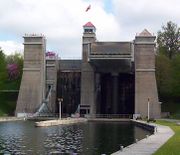
The first major events of the 20th Century in Peterborough occurred in 1904. The first occurrence was the village of Ashburnham, founded in 1859 and situated on the eastern shore of the Otonabee River, being annexed to Peterborough. This significantly increased the size of the growing city. This area of the city is still referred to as "East City" by local residents and is regarded as a somewhat separate entity to Peterborough proper. It has maintained an identity within the city and is one of the more well known neighbourhoods. The second occurrence was the completion of the Peterborough Lift Lock on July 9, eight years after construction was initially approved. To this day, many landmarks in Peterborough memorialise Richard Rogers, conceptual father of the Lift Lock, such as Rogers Cove on Little Lake and Rogers Street in the eastern part of the city.
In 1905, Peterborough was incorporated as a city on Dominion Day, with a population of about 14,300. The city's flag and coat of arms were adopted later, in 1951.
In the 1970s, the Ontario Government helped sponsor the building of Peterborough Square with the aid of the Ontario Downtown Renewal Programme (ODRP). The mall was anchored by an Eaton's store until the collapse of the Eaton's chain of stores in the late 1990s, it now houses offices, stores and a food court. The provincial government relocated the central office of the Ministry of Natural Resources to 300 Water Street, kitty corner from Peterborough Square. With two of Canada's top rated post secondary schools, Trent University and Fleming College, the region has a wealth of research and labour development opportunities. On top of all of the advantageous economic and market-access factors Peterborough is located in one of Canada's premier lake districts—the Kawarthas—providing sport, recreation and lifestyle opportunities. In 2008, a new regional hospital officially opened in Peterborough.
Geography
Peterborough is situated in South Eastern Ontario, on the northeastern edge of the Greater Golden Horseshoe and heart of the Kawartha Lakes region in Ontario. Peterborough lies in the St. Lawrence Lowlands ecoregion in Canada, just south of the Canadian Shield and about 35 kilometres north of Lake Ontario. The city is centred around a series of rapids in the Otonabee River, approximately halfway between where it begins at Katchewanooka Lake and where it empties into Rice Lake. The urban area of Peterborough completely surrounds the only lake on the Otonabee, Little Lake, and the Trent Canal runs along the eastern edge of the city, connecting Little Lake to a section of the Otonabee above the rapids.
Topography
The South End and Downtown portions of the City sit on what was the bottom of the glacial Lake Peterborough, the remnants of which now form the Otonabee River. This area of relatively low and flat relief (approximately 191–200 m (625–645 ft.) above sea level) is prone to flooding, exemplified in the major flood that occurred on July 14, 2004. The elevation quickly rises to the west, north, and east where a series of hills (the Peterborough Drumlin field) dominate the landscape. Much of the land in the North and West Ends of the City rises to 230–274 metres (750–900 feet) above sea level, with the recently annexed Tower Hill, at 286 m (942 ft.) a.s.l., being the highest point in the City. Armour Hill, another prominent drumlin located in East City, forms the physical obstacle which the Trent-Severn Waterway ascends by way of the Peterborough Lift Lock. Approximately 15 kilometres south of the city, runs the eastern section of the Oak Ridges Moraine.
Climate
By the Köppen climate classification, Peterborough falls under Dfb classification, which categorizes it as a Warm Summer Continental region. Peterborough's Hardiness zone is 5a. Peterborough's climate can be quite unpredictable and vary greatly from one part of the City to another due to the effects of the Oak Ridges Moraine. In the South End and south of the City, the Moraine acts as a barrier for weather patterns coming off Lake Ontario, reducing precipitation. In the North and West Ends of Peterborough the effects of the Moraine are not as prominent, at times creating slightly cooler temperatures and more precipitation than the more southern parts of the City and County.
| Climate data for Peterborough | |||||||||||||
|---|---|---|---|---|---|---|---|---|---|---|---|---|---|
| Month | Jan | Feb | Mar | Apr | May | Jun | Jul | Aug | Sep | Oct | Nov | Dec | Year |
| Source: Environment Canada[8] | |||||||||||||
Demographics
| Historical Populations[9] | |||
|---|---|---|---|
| 1841 | 2,000 | ||
| 1851 | 2,191 | ||
| 1871 | 4,611 | ||
| 1881 | 6,812 | ||
| 1891 | 9,717 | ||
| 1901 | 11,239 | ||
| 1911 | 18,360 | ||
| 1921 | 20,994 | ||
| 1931 | 22,372 | ||
| 1941 | 24,977 | ||
| 1951 | 38,272 | ||
| 1961 | 47,185 | ||
| 1971 | 58,111 | ||
| 1981 | 60,620 | ||
| 1991 | 68,371 | ||
| 2001 | 71,446 | ||
| 2006 | 74,898 | ||
As of the 2006 Canadian Census, there were 74,898 people and 33,042 dwellings (31,204 occupied) in the city. This is up from 71,446 people in 2001 for a growth rate of 4.8%. This is well below both Ontario's overall growth rate (6.8%) and Canada's growth rate (5.4%).[1] The population density of the city is 1,282.6 people per square kilometre. It is anticipated that the city's population will grow to approximately 98,900 by 2017.
The population of Peterborough's CMA, which consists of the city of Peterborough as well as the surrounding townships of Smith-Ennismore-Lakefield, Douro-Dummer, Otonabee-South Monaghan and Cavan-Monaghan; stood at 116,570 in 2006. This positions it as the 33rd largest metropolitan area in Canada (14th in Ontario). The population is up from 110,876 in 2001 for a growth rate of 5.1%. This suggests a trend of greater growth outside of Peterborough city limits.[3] Communities within Peterborough's CMA include Millbrook, Bridgenorth and Lakefield. The population density of Peterborough (CMA) averaged 85.4 people per square kilometre, compared with an average of 12.6 people per square kilometre (32.6/sq mi) for the province.
In 2006, the resident population 14 years or younger made up 15.7% of the general population, while 18.2% were 65 or older. The median age for the CMA was 42.8, which is the fifth highest of Canada's thirty-three Census Metropolitan Areas, behind Trois-Rivières, Saguenay, Kelowna and Victoria.[10]
Peterborough's population is predominantly Caucasian, with only 3.1% of the population identifying as Aboriginal[11] and 2.7% identifying as a visible minority;[12] made up of 0.6% South Asian, 0.6% Chinese, 0.5% Black, 0.1% Filipino, 0.2% Latin American and 0.2% Southeast Asian. Peterborough is also primarily an English-speaking city, with 92.5% of the population speaking it as their mother tongue. French is spoken by 1.1% of the population, and other languages are spoken by 5.9% of the population.[13]
Economy
| Top Eight Major Employers[14] | |||
|---|---|---|---|
| Employer | Employment Numbers | ||
| Peterborough Regional Health Centre | 2075 | ||
| Kawartha Pine Ridge District School Board | 2050 | ||
| General Electric | 1450 | ||
| City of Peterborough | 1267 | ||
| Sir Sandford Fleming College | 1100 | ||
| Ministry of Natural Resources | 895 | ||
| Trent University | 700 | ||
| PepsiCo Foods (Quaker) | 700 | ||
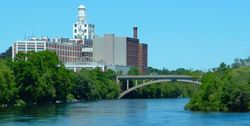
No longer the dominant local industry, manufacturing is still one of the key sectors along with food processing, automotive supplies, electronics, aerospace and life sciences/biotechnology. General Electric and Quaker Oats maintain large operations in Peterborough, as well, the city is also a 'bedroom' community for workers commuting to Oshawa and East Toronto. The Peterborough Regional Health Centre is the largest employer, planning to hire 800 more over the next three years, adding to its current employment total of over 2,000. School boards, local government, Trent University and the Ontario Ministry of Natural Resources are other large employers.
Companies like General Electric have had a major impact on the growth of the city. The North American Free Trade Agreement (NAFTA) of the early 1990s saw a major shift in trading patterns for many Canadian companies. Other innovations like just in time delivery and pressure to produce ever cheaper goods impacted some of the large multi-nationals in the 1970s and 1980s. Despite this, today GE, PepsiCo Quaker, Siemens and numerous smaller manufacturing companies are experiencing significant growth. Minute Maid (Coca-Cola) recently invested $CDN20 million in a new warehouse and product line while auto parts supplier Ventra has doubled in size. United Canadian Malt Ltd. is a manufacturer of a wide variety of extracts of malted barley, and other grains.[15] Manufacturing job creation kept pace with the provincial average from 1991–2001. Lower costs, reliable labour and high quality post-secondary institutions are a competitive advantage for Peterborough. Peterborough was ranked number one location for business in Ontario by Canadian Business magazine in late 2004.
Peterborough is a major shopping destination for the region and is home to three shopping centres; Peterborough Square, located at George and Simcoe Streets, Portage Place at 1154 Chemong Road, and Lansdowne Place at 645 Lansdowne Street West. All have undergone major renovations in recent years, with Lansdowne Place currently in the process of expanding. Both Walmart and Costco have large stores in Peterborough, which draw clients from the surrounding area.
Arts and culture

Artspace is one of Canada's oldest artist-run art centres, founded in 1974. Its mandate is to support the growth and development of contemporary artists. Artspace maintains a public gallery. Noted artist David Bierk was one of the founding members.
The Art Gallery of Peterborough was also founded in 1974 and features rotating exhibitions by local, national, and international artists.
Peterborough is also home of the Kawartha Artists Gallery, a group of amateur artists. Formed in 1991, under the leadership of Monica Jackson, the KAGS meets in the basement of the De La Fosse Library in Peterborough's south end. A variety of artists meet there: Weavers, Monday mornings; Life Drawing, Tuesday mornings; Still Life, Wednesday mornings; Portrait, Wednesday afternoons (September-June); and Outdoor Artists, Thursday mornings (indoors October-April). There are a number of single artist and multi-member exhibits in paint (abstract and representational), various media and photography.
Peterborough New Dance and Public Energy was founded by Bill Kimball in 1994, and is a presenter and animator of contemporary dance and performance. It is the only full-time presenter of contemporary dance in Ontario outside of Toronto and Ottawa. The organization also supports the development of local dance and performance artists, produces the annual Emergency festival of new dance featuring area artists, and presents indigenous performing artists.
The Peterborough Symphony Orchestra was incorporated in 1967, with historical roots reaching back before the turn of the century. The PSO presents symphonic music. Music Director Michael Newnham has led the organization since 2001, which offers concerts and educational outreach programming to Peterborough and beyond.
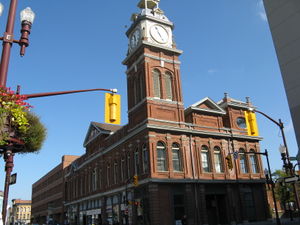
The Peterborough Folk Festival was founded in 1989 by a collective of artists; this three-day August festival has supported a number of local and Canadian artists. Its Emerging Artist Award, founded in 2001 by Reverend Ken Ramsden, has honoured Serena Ryder, James McKenty, and Benj Rowland amongst others.
The Starfire Band was originally formed in 1999 by Peter Ford. It was an offshoot of the Kawartha Wind Symphony, which was composed of the older generation of musicians. The Starfire band was created for the younger generation of musicians and consists of students from Grade 7 to Grade 12 in the Peterborough area who are interested in music, not necessarily with any or much experience.
Peterborough has a resident professional theatre company; New Stages. Founded in 1997 by Randy Read, New Stages produces new Canadian and American plays, and runs a highly successful reading series of "edgier" work. New Stages is a fully equity company and uses both Showplace Peterborough and the Market Hall Performing Arts Centre.
Peterborough is also well known for its thriving music scene, and is home to musicians and bands such as Hawk Nelson, I Mother Earth, The Spades, Thousand Foot Krutch, Rick Fines, Jimmy Bowskill, The Burning Hell (band), The Silver Hearts, Birthday Boys, Rikers, Elyse Bruce and Washboard Hank, amongst many others.
Attractions
Peterborough and the Kawarthas offer a multitude of attractions and events for all demographics. Rich in heritage, the region is host to an amazing array of museums, cultural exhibitions, indoor and outdoor galleries and theatres, Aboriginal heritage attractions and historical sites, as well as a vibrant arts community.
The Peterborough Centennial Museum & Archives is home to a diverse collection of artifacts. It was established in 1897 and moved to its present site on Armour Hill in 1967. The Archives collection includes items from Catharine Parr Traill, the original Peter Robinson papers, the Park Studio Fonds and the Balsillie collection of Roy Studio Images, over 300,000 film and glass plate negatives dating back to 1896.
The Trent-Severn Waterway passes through Peterborough and includes the Peterborough Lift Lock, the world's largest hydraulic lift lock, which opened in 1904. It is also the world's highest hydraulic lift lock with a rise of 65 feet (19.8 m).
Del Crary Park is a large urban greenspace on Little Lake, located in close proximity to downtown Peterborough that is also home of the Peterborough Yacht Club. Free outdoor events and concerts are held here during the summer months, including the international Festival of Lights fireworks displays, Wednesday and Saturday evenings from June through August. The Art Gallery of Peterborough, opened in 1974, is situated on the shore of Little Lake beside Del Crary Park and features 1,300 pieces from around the world.
Showplace Performance Centre is a 647-seat, state of the art performance facility located downtown that opened in 1996. The Canadian Canoe Museum, located on Monaghan Road, is a unique national heritage centre that explores the canoe's enduring significance to the peoples of North America.
The Riverview Park & Zoo is a 55.5-acre (22.5 ha) zoo operated by the Peterborough Utilities Group at the North end of Water Street. In addition to its animal exhibits, the zoo features a miniature train ride and the park contains a disc golf course.
The Peterborough Skateboard park is one of the largest skateboard parks in Ontario. It includes several half-pipes as well as multiple ramps and rails. Its construction was sponsored by West 49.
Annual events
- Artsweek - annual celebration of the arts in Peterborough, held in September
- Downtown Countdown - alcohol/drug-free New Year's Eve celebration (website currently down)
- Emergency: Festival of New Dance and Performance by Peterborough Area Artists - festival held in late March/early April, produced by Public Energy and Peterborough New Dance
- Festival of Trees - fundraiser in support of local healthcare built around a show of decorated Christmas trees and other seasonally-themed displays, late November, Memorial Centre
- Peterborough Folk Festival [1] - three-day music, arts and community festival, featuring free all-day outdoor event with five stages, traditionally held last weekend in August
- The Ontario municipal holiday (held on the first Monday in August) which is called Simcoe Day in Toronto and Colonel By Day in Ottawa is called Peter Robinson Day locally
- Little Lake MusicFest - Formally known as Peterborough Summer Festival of Lights:''free concert series Wednesdays and Saturdays from June to August, Del Crary Park George St S"
- Peterborough Kinsmen Santa Claus Parade[2] - first Saturday of December at 5:00 pm.
Sports and recreation
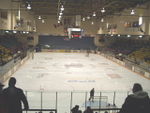
Peterborough has many sports and recreational opportunities.
Peterborough is well known for its junior level hockey team, the Peterborough Petes of the Ontario Hockey League. The 'Petes' were established in 1956 and have become the longest continuously operating team in the league.[16] They have participated in the Memorial Cup tournament nine times in their history and won it once. The Petes have produced a record number of National Hockey League (NHL) players such as Eric Staal, Jordan Staal, Mike Fisher, Cory Stillman, Chris Pronger, Steve Yzerman, Bob Gainey, Mike Ricci, Larry Murphy, Tie Domi, and coaches such as Scotty Bowman, Roger Neilson, Mike Keenan, Gary Green and Dick Todd. They have also graduated 96 players who have played 100 or more games in the NHL.[17]
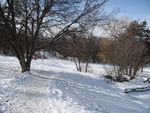
The Peterborough Memorial Centre, constructed in 1956, is the home of the Peterborough Petes and was named in honour of the many war veterans who came from the region. It is located at the east of the exhibition grounds at the corner of Lansdowne and George Streets. In 2003, the Memorial Centre was renovated adding 24 luxury box suites, improved concessions, a licensed restaurant, new seats, boards, scoreboard and also air conditioning.
The city carries a Tier II Junior "A" team known as the Peterborough Stars that play in the Ontario Provincial Junior A Hockey League.The city also has a youth women's hockey team called the Peterborough Ice Kats. Box lacrosse is also popular in the area. The city's two major teams are the Peterborough Lakers (defending Major Series Lacrosse champions) and the Peterborough Jr. Lakers.
The Trans Canada Trail runs through the city and there are a few other multiple-use trails available.
A portion of the Trent-Severn Canal below the lift lock is flooded and maintained for skating each winter.
Government
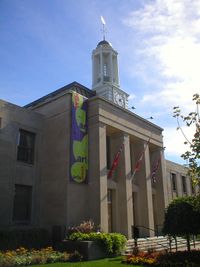
Peterborough is a single-tier municipality governed by a mayor-council system. The Mayor of Peterborough is elected by direct popular vote to serve as the chief executive of the city. The Peterborough City Council is a unicameral legislative body, comprising the Mayor and ten city councillors representing five geographical wards of the city. The present wards are as follows;
| Otonabee Ward | Eric Martin and J. Douglas Peacock | ||||
| Monaghan Ward | Henry Clarke and Jack Doris | ||||
| Town Ward | Ann E. Farquharson and Dean Pappas | ||||
| Ashburnham Ward | Patti S. Peeters and Len Vass | ||||
| Northrest Ward | Shirley Eggleton and Bob Hall |
Peterborough City Hall at 500 George Street North in downtown Peterborough and also houses the central offices of Peterborough Social Services. The municipal budget for 2008 for the city is projected to be $190.9 million, an increase from 2007's actual expenditures of $185.4 million, or 2.9%.[18]
Prior to the city being separated from it, the city was also the seat of Peterborough County. The Peterborough County Court House is located at 470 Water Street and was built between the years of 1838 and 1840[19] and still holds a portion of the county's offices.
Peterborough is currently represented at the federal level by Dean Del Mastro, MP, of the Conservative Party of Canada, who has served since the 2006 federal election. At the provincial level, the riding is held by Jeff Leal, MPP, of the Ontario Liberal Party, who has held it since the 2003 Ontario election.
Infrastructure
Roads and highways
Peterborough is served by provincial Highway 115 (from Highway 401) and the Highway 7 junction, which becomes the Peterborough By-Pass. The eastern segment of Highway 7 was separated from the central segment by 6 km until the creation of the By-Pass. This freeway-style highway runs 12.5 km off Highway 115 with five entrance routes into the city. Its entire length is part of the Trans-Canada Highway. Other Provincial Highways important to Peterborough are Highway 7A, which junctions onto Highway 115 just southwest of the city, and Highway 28, which routes from Highway 7 just east of the city to Lakefield and on further north.
The area is also served by numerous county roads.
There are four road bridges which cross the Otonabee River within the city limits of Peterborough. The most northerly one is the Nassau Mills Road Bridge near Trent University. The next most northerly bridge is the Parkhill Road Bridge. The Hunter Street Bridge crosses the river just north of Little Lake, linking East City with the downtown core. The most southerly bridge is the Lansdowne Street Bridge. In addition, Highway 115 crosses the river near the southern edge of the city. There are also numerous other bridges which cross the Trent Canal (notably the crossing at the lift lock which actually passes under the canal), Jackson Creek and the other minor creeks in the city. There are also numerous other river crossings throughout the CMA, the longest of which is the James A. Gifford Causeway, which crosses Chemong Lake linking Bridgenorth with Ennismore.
Public transit in the city of Peterborough is currently run by Peterborough Transit, providing a total of 12 regular and 5 express routes throughout the city.
Peterborough Transit's hub is a central terminal located on Simcoe Street in the city's downtown core. It also serves as the regional terminus for Coach Canada (formerly Trentway Wagar) routes into the city. Greyhound Lines of Canada operates an inter-city terminal nearby at the corner of Simcoe and Aylmer Streets, with several daily commuter buses to and from Toronto. GO Transit established a bus service from Peterborough to Oshawa starting September 5, 2009.
Railways
Peterborough is served by Canadian Pacific Railway. No passenger services currently exist, but the federal government plans to reinstate them and significant progress had been made in 2008. Dean Del Mastro, MP, lobbied for passenger rail to be brought back to the small city, and there has been government funding put aside for a Peterborough–Toronto rail link.[20]
Air and water transportation
Peterborough Airport is located off Highway 115, just south of the city. It is primarily a recreation and business airport, offering no scheduled flights by any airlines. Its 5000-foot paved runway is the longest between Toronto and Ottawa and sees approximately 31,000 aircraft movements per year.[21]
Otonabee River is part of the Trent-Severn Waterway, providing a link from Lake Ontario to Lake Huron. Also, the Trent Canal runs through the very eastern portion of the city and is home to the Peterborough Lift Lock, the highest hydraulic boat lift in the world. The Peterborough Marina is located on Little Lake near where Jackson Creek drains into the lake, beside Del Crary Park and just east of George Street. It contains 90 slips for docking and a host of amenities.[22]
Utilities
Peterborough is served by the Peterborough Utilities Group (PUG), formerly the Peterborough Utilities Commission, which provides electricity and water to the city and its residents. It is currently 100%-owned by the City of Peterborough. They have been in operation for over 90 years. The PUG has recently started expanding outside of just distributing water and electricity within the city and have begun to develop and operate electricity generation (notably the Trent Rapids project), telecom services, energy equipment rentals, and commercial metering services both in Peterborough and throughout the province.[23]
Natural gas for heating is provided locally by Enbridge Inc.[3]
Healthcare
Peterborough is home to the Peterborough Regional Health Centre (PRHC), which serves Peterborough, Peterborough County, Northumberland County, the City of Kawartha Lakes, Haliburton County and Hastings County. It is located at 1 Hospital Drive and prior to the completion of its new facility in June 2008, also provided some services from the old St. Joseph's site at 384 Rogers Street. The PRHC is part of the Central East Local Health Integration Network, provides 494 beds and houses one of the busiest emergency departments in Ontario.[24]
Education
- See also the category Schools in Peterborough, Ontario
School boards in Peterborough
The Kawartha Pine Ridge District School Board (KPRDSB) is the public English language school board that serves the local area. Its headquarters are located at 1994 Fisher Drive, Peterborough. Over 35,000 students attend its schools and it encompasses almost 7,000 square kilometres,[25] and takes the place of the former Peterborough County Board of Education and Northumberland-Clarington Board of Education. It stretches from the north of Peterborough County south to Lake Ontario, and from Hastings County in the east, to the City of Kawartha Lakes and the City of Oshawa in the west. As of 2010, the KPRDSB operates 82 elementary schools, 15 secondary schools and four adult learning centres serving both the urban area and the outlying rural communities. Of those, 16 elementary schools, five secondary schools and a single adult learning centre are located within the city.
The Peterborough Victoria Northumberland and Clarington Catholic District School Board is the Separate English language school board for the region. It is headquartered at 1355 Lansdowne Street West, Peterborough and presently operates 33 elementary schools and five secondary schools. Of these, nine elementary and two secondary schools operate within the city.
The Conseil scolaire de district catholique Centre-Sud is the Separate French language school board for the South-Central region of Ontario, which includes Peterborough. It presently operates 41 elementary schools and eight secondary schools, of which the only school in Peterborough is the elementary school Monseigneur-Jamot.
Post-secondary institutions
Trent University
Established in 1964, Trent University is a small liberal arts- and science-oriented institution. Trent's academic focus is on environmental, cultural and science studies. The main Symons Campus of Trent, located in the city's far north end, is approximately 14.6 square kilometres, over half of which is a part of Trent's Nature Areas, an ecologically diverse wild-life preserve.
Trent University is divided into a series of colleges: Champlain, Lady Eaton, Catharine Parr Traill, Otonabee, Peter Gzowski and Julian Blackburn. Each college has its own residence hall, dining room and student government, except for Julian Blackburn, which consists only of part-time students.
Fleming College
Established in 1967, Fleming College, (formerly Sir Sandford Fleming College), is a multidisciplinary institution with two primary campuses within the city of Peterborough:
McRae Campus is located in a renovated textile mill located on McDonnel Street near Monaghan Road and is home to the School of Continuing Education and Skilled Trades.
Sutherland Campus is located on Brealey Drive in the city's west end, and has recently undergone a massive expansion. The new St. Joseph's at Fleming is the first long-term care facility to be built on a college or university campus. In 2005, the Peterborough Sport & Wellness Centre was constructed to accommodate the college's athletic needs.
The college also operates satellite campuses in nearby Lindsay, Cobourg and Haliburton.
Public library system
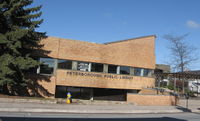
The Peterborough Mechanics Institute, established in 1868, housed a subscription library that allowed members who paid a fee to borrow books. Mechanics Institutes were established across Ontario to make education universal and accessible to all citizens. In Peterborough, the Institute and the Library were located on Water Street. In May 1895, the Mechanics Institute became the Peterborough Public Library. The library remained on Water Street.
Later, the Peterborough Public Library received funding from the Andrew Carnegie Foundation and the new Carnegie Library located on George Street opened in 1911. This building is currently the Carnegie Wing of City Hall.
In February 1949, a branch library opened in the south end of Peterborough. It was situated above a hardware store and was a room 50 by 20 feet. It was divided into two sections—one for children, the other for adults.
The DelaFosse Branch Library opened officially on December 1, 1965. The Peterborough Examiner declared that this branch at 729 Park Street S., made "south end residents the envy of the rest of the city." Currently, it holds a recreational reading collection of approximately 14,000 hardcover and paperback books for all ages. Recent additions to the collection include a variety of multimedia including CDs, DVDs, CD-ROMs and CD audio books. This branch library is named in honour of Frederick Montague de la Fosse, who was the Chief Librarian of Peterborough Public Library from 1910 to 1946.
The Main Library at 345 Aylmer Street N. opened on September 2, 1980. The new library was built on the site of the old fire hall and had about triple the floor space of the old Carnegie building. The opening ceremonies were on September 17 and featured Dr. Robertson Davies, Master of Massey College, University of Toronto, as the keynote speaker.
The Main Library is a full service library with a well-stocked current circulating collection of books, CD audio books, CD-Music, DVDs and magazines. In addition to encyclopedias and dictionaries, the Reference Collection includes a local history collection, government documents, electronic resources and microforms selected to answer the information needs of our community. The library was recently used for the filming of the 2008-Bound Motion Picture Jumper.[26]
Media
Peterborough is home to a disproportionately large number of radio stations compared to centres closer to Toronto. This is due in part to Peterborough's central location in a valley. Peterborough is also home to two television stations; CHEX-TV is a local affiliate to CBC and TVCogeco is a community cable channel provided by Cogeco. Peterborough has two main newspapers, the Peterborough Examiner, which publishes six days a week minus Sunday, and Peterborough This Week, which publishes every Wednesday and Friday.
Notable current and former residents
Sir Sandford Fleming originally came to the town in the late 1840s with his first impression finding it to be "rather a poor little place".[27] However, since, there have been a number of people of note, including athletes, musicians, authors and more who made Peterborough their home. Two of particular note are Catherine Parr Traill, the author of The Backwoods of Canada, who was an early settler, and Lester B. Pearson, the former Prime Minister, who attended local school PCVS. Current residents include:
- Sebastian Bach, singer/musician (Skid Row)
- Jim Balsillie, billionaire, co-CEO of Research in Motion
- Roberta Bondar, astronaut
- Dave Carley, playwright
- Sean Cullen, comedian
- Robertson Davies, author
- Mike Fisher, Ottawa Senators NHL player
- Matt Frewer, Canadian and American stage, TV, and film actor, best known role Max Headroom
- Bob Gainey, NHL all-star player from the Montreal Canadians
- Emily Haines, composer and musician
- Ronnie Hawkins (Lakefield), musician
- Linda Kash, actor
- Paul Nicholas Mason, author
- Serena Ryder, singer/songwriter
- Paul Soles, actor
- Jagori and Christian Tanna, musicians (I Mother Earth)
- Estella Warren, model and actress
- Eberhard Zeidler, architect[28]
- Adam Gontier, singer of Three Days Grace
See also
- Peterborough County, Ontario
- Peterborough Transit
- Trent University
References
- ↑ 1.0 1.1 1.2 "Population and dwelling counts, for Canada, provinces and territories, and census subdivisions (municipalities), 2006 and 2001 censuses - 100% data". Statistics Canada, 2006 Census of Population. 2007-03-13. http://www12.statcan.ca/english/census06/data/popdwell/Table.cfm?T=302&SR=401&S=1&O=A&RPP=25&PR=35&CMA=0. Retrieved 2008-10-29.
- ↑ 2.0 2.1 "Population and dwelling counts, for urban areas, 2006 and 2001 censuses - 100% data". Statistics Canada, 2006 Census of Population. 2007-03-13. http://www12.statcan.ca/english/census06/data/popdwell/Table.cfm?T=801&PR=0&SR=1&S=3&O=D. Retrieved 2008-10-29.
- ↑ 3.0 3.1 3.2 "Population and dwelling counts, for census metropolitan areas, 2006 and 2001 censuses - 100% data". Statistics Canada, 2006 Census of Population. 2007-03-13. http://www12.statcan.ca/english/census06/data/popdwell/Table.cfm?T=205&RPP=50. Retrieved 2008-10-29.
- ↑ "University of Michigan International Center". University of Michigan. http://www.internationalcenter.umich.edu/about/services.html. Retrieved 2008-12-08.
- ↑ "Directory of Designations of National Historic Significance of Canada - Serpent Mounds National Historic Site of Canada". Parks Canada. 2005-02-22. http://www.pc.gc.ca/apps/lhn-nhs/det_E.asp?oqSID=0518&oqeName=Serpent+Mounds&oqfName=Tumulus+Serpent. Retrieved 2009-01-11.
- ↑ "Peterborough and the Kawarthas". Trent University Department of Geography. 2008-09-26. http://www.trentu.ca/academic/geography/PATKch7p101.html. Retrieved 2008-10-29.
- ↑ "A History of Peterborough's Canoe Industry". Peterborough Centennial Museum and Archives. 1997. http://www.peterboroughmuseumandarchives.ca/canoe.htm. Retrieved 2008-12-08.
- ↑ Environment Canada—Canadian Climate Normals 1971–2000. Retrieved 29 October 2009.
- ↑ "Peterborough and the Kawarthas". Trent University Department of Geography. 2008-09-26. http://www.trentu.ca/academic/geography/PATKch8p133.html. Retrieved 2009-01-11.
- ↑ "Age and Sex, median age by sex along with age group ratios for both sexes, for Canada and census metropolitan areas and census agglomerations". Statistics Canada, 2006 Census of Population. 2007-08-10. http://www12.statcan.ca/english/census06/data/highlights/agesex/pages/Page.cfm?Lang=E&Geo=CMA&Code=01&Table=2&Data=Count&Sex=1&StartRec=26&Sort=23&Display=Page&CSDFilter=5000. Retrieved 2008-10-29.
- ↑ "Aboriginal Peoples Highlight Table". Statistics Canada, 2006 Census of Population. 2008-01-15. http://www12.statcan.ca/census-recensement/2006/dp-pd/hlt/97-558/index.cfm?Lang=E#Notes. Retrieved 2009-01-11.
- ↑ "Ethnocultural Portrait of Canada Highlight Table". Statistics Canada, 2006 Census of Population. 2008-04-02. http://www12.statcan.ca/census-recensement/2006/dp-pd/hlt/97-558/index.cfm?Lang=E#Notes. Retrieved 2009-01-11.
- ↑ "Population of Mother Tongue". Statistics Canada, 2006 Census of Population. 2007-12-03. http://www12.statcan.ca/english/census06/data/highlights/Language/Table401.cfm. Retrieved 2009-01-11.
- ↑ "2008 Community Profile". Greater Peterborough Area Economic Development Corporation. 2008-09. http://www.gpaedc.on.ca/pdfs/2008/2008%20Community%20Profile%20for%20web.pdf. Retrieved 2008-10-30.
- ↑ "United Canadian Malt". United Canadian Malt. http://www.unitedcanadianmalt.ca/. Retrieved 2009-01-01.
- ↑ "The Peterborough Petes - Tradition - History". http://www.gopetesgo.com/tradition.php. Retrieved 2008-12-08.
- ↑ "The Peterborough Petes - Tradition - Petes in the NHL". http://www.gopetesgo.com/tradition.php?show=NHL. Retrieved 2008-12-08.
- ↑ "2008 Complete Budget Highlights Book". Peterborough City Council. 2007-11. http://www.peterborough.ca/Assets/Documents/Finance/Budget/2008+Budget/2008+Budget+Complete+Highlights+Book.pdf.pdf. Retrieved 2008-10-31.
- ↑ "County of Peterborough :: Historical Overview". County of Peterborough. 2005. http://www.county.peterborourgh.on.ca/government/index.php. Retrieved 2008-10-31.
- ↑ Kalinowski, Tess; Teotonio, Isabel (2008-02-28). "The Star - Federal Budget - Peterborough awarded high-speed rail". The Toronto Star. http://www.thestar.com/News/FederalBudget/article/307725. Retrieved 2008-11-03.
- ↑ "Airport". City of Peterborough. http://www.peterborough.ca/Visiting/Airport.htm. Retrieved 2008-11-03.
- ↑ "Marina Amenities". http://www.peterboroughmarina.ca/Marina_Amenities.htm. Retrieved 2008-11-03.
- ↑ "Peterborough Utilities Group - Corporate - About Us". Peterborough Utilities Group. http://www.peterboroughutilities.ca/Corporate.htm. Retrieved 2008-12-09.
- ↑ "Peterborough Regional Health Centre - Official Site - About Us". Peterborough Regional Health Centre. http://www.prhc.on.ca/Site%20Map/About%20Us.aspx. Retrieved 2009-02-03.
- ↑ "About Us". Kawartha Pine Ridge District School Board. http://www.kprschools.ca/aboutus/general_info.php. Retrieved 2008-11-03.
- ↑ "Film crew jumps around the city". myKawartha. 2006-09-05. http://www.mykawartha.com/news/article/4128. Retrieved 2008-12-08.
- ↑ "Diaries of Sir Sandford Fleming". 1845-06-17. http://www.chass.utoronto.ca/history/material_culture/sfaulkne/arch.htm. Retrieved 2008-12-08.
- ↑ Dave LeBlanc, "The Bauhaus in Peterborough", Globe and Mail, March 13, 2009
External links
- City of Peterborough homepage
- County of Peterborough homepage
- Peterborough Centennial Museum and Archives
- Canadian Canoe Museum
- Peterborough Wiki - community WikiSpot wiki about all things Peterborough.
 |
Smith-Ennismore-Lakefield |  |
||
| Cavan-Monaghan | Douro-Dummer | |||
| Otonabee-South Monaghan |
|
||||||||||||||||||||||||||
|
|||||||||||||||||||||||
|
|||||
–

